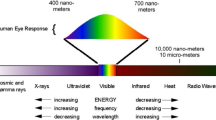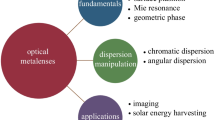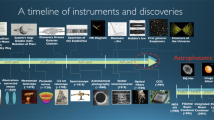Abstract
Most dielectric materials have very weak electro-optic properties, whereas the optical properties of some plasmonic materials may be greatly tuned, especially around their plasma frequency, where dielectric constant is transiting between positive (“dielectric state”) and negative (“metallic state”) values. In this talk, we will review some of our recent work on electro-optical modulation and introduce a new concept, photonic MOS based on “optical property inversion”. This concept may provide inspiration for the development of nanophotonic devices. While the whole paper only discusses theory and modelling, some new experimental results will be presented in the on-site talk. Throughout this report, “static dielectric constant”, ɛ, refers to material dielectric constant in the DC or radio frequency (RF) regime; “optical dielectric constant”, ε, represents material dielectric constant in the near-infrared regime. This paper was re-written based on an Arxiv file [1].
Similar content being viewed by others
References Cited
Z. Lu and K. Shi, “Photonic MOS Based on ‘Optical Property Inversion’,” arXiv:1504.07546 (2015).
G. T. Reed, G. Mashanovich, F. Y. Gardes, and D. J. Thomson, “Silicon optical modulators,” Nat. Photonics 4, 518–526 (2010).
B. G. Lee, A. Biberman, J. Chan, and K. Bergman, “High-Performance Modulator and Switches for Silicon Photonic Networks-on-Chip,” IEEE J. Sel. Top. Quant. Electron. 16, 6–22 (2010).
Y. H. Kuo, Y. K. Lee, Y. Ge, S. Ren, J. E. Roth, T. I. Kamins, D. A. B. Miller, and J. S. Harris, “Strong quantum-confined Stark effect in germanium quantum-well structures on silicon,” Nature 437, 1334–1336 (2005).
F. G. Della Corte, S. Rao, M. A. Nigro, F. Suriano, and C. Summonte, “Electro-optically induced absorption in α-Si:H/α-SiCN waveguiding multistacks,” Opt. Express 16, 7540–7550 (2008).
J. Liu., M. Beals, A. Pomerene, S. Bernardis, R. Sun, J. Cheng, L. C. Kimerling, and J. Michel, “Waveguide-integrated, ultralow-energy GeSi electro-absorption modulators,” Nature Photon. 2, 433–437 (2008).
H.W. Chen, Y. H. Kuo, and J. E. Bowers, “25Gb/s hybrid silicon switch using a capacitively loaded traveling wave electrode,” Opt. Express 18, 1070–1075 (2010).
Y. Rong, Y. Ge, Y. Huo, M. Fiorentino, M.R.T. Tan, T. Kamins, T.J. Ochalski, G. Huyet, and J.S. Harris, “Quantum-confined Stark effect in Ge/SiGe quantum wells on Si,” IEEE J. Sel. Top. Quant. Electron. 16, 85–92 (2010).
R. Soref and B. Bennett, “Electrooptical effects in silicon,” IEEE J. Quant. Electron. 23, 123–129 (1987).
A. Yariv and P. Yeh, Photonics: Optical Electronics in Modern Communications Ch. 9 (pp 406–464), (Oxford University Press, 6th edition, 2006).
E.L. Wooten, K.M. Kissa, A. Yi-Yan, E.J. Murphy, D.A. Lafaw, P.F. Hallemeier, D. Maack, D.V. Attanasio, D.J. Fritz, G.J. McBrien, and D.E. Bossi, “A review of lithium niobate modulators for fiber-optic communication systems,” IEEE J. Sel. Top. Quantum Electron. 6, 69–82 (2000).
A. Liu, R. Jones, L. Liao, D. Samara-Rubio, D. Rubin, O. Cohen, R. Nicolaescu, and M. Paniccia, “A high-speed silicon optical modulator based on a metal-oxide-semiconductor capacitor,” Nature 427, 615–618 (2004).
Q. Xu, B. Schmidt, S. Pradhan, and M. Lipson, “Micrometre-scale silicon electro-optic modulator,” Nature 435, 325–327 (2005).
R.S. Jacobsen, K.N. Andersen, P.I. Borel, J. Fage-Pedersen, L.H. Frandsen, O. Hansen, M. Kristensen, A. V. Lavrinenko, G. Moulin, H. Ou, C. Peucheret, B. Zsigri, and A. Bjarklev, “Strained silicon as a new electro-optic material,” Nature 441, 199–202 (2006).
Q. Xu, S. Manipatruni, B. Schmidt, J. Shakya, and M. Lipson, “12.5 Gbit/s carrier-injection-based silicon microring silicon modulators,” Opt. Express 15, 430–436 (2007).
J. Teng, P. Dumon, W. Bogaerts, H. Zhang, X. Jian, X. Han, M. Zhao, G. Morthier, and R. Baets, “Athermal silicon-on-insulator ring resonators by overlaying a polymer cladding on narrowed waveguides,” Opt. Express 17, 14627–14633 (2009).
B. Guha, B. B. C. Kyotoku, and M. Lipson, “CMOS-compatible athermal silicon microring resonators,” Opt. Express 18, 3487–3493 (2010).
D. J. Thomson, F. Y. Gardes, Y. Hu, G. Mashanovich, M. Fournier, P. Grosse, J-M. Fedeli, and G. T. Reed, “High contrast 40Gbit/s optical modulation in silicon,” Opt. Express 19, 11507–11516 (2011).
L. Alloatti, D. Korn, R. Palmer, D. Hillerkuss, J. Li, A. Barklund, R. Dinu, J. Wieland, M. Fournier, J. Fedeli, H. Yu, W. Bogaerts, P. Dumon, R. Baets, C. Koos, W. Freude, and J. Leuthold, “42.7 Gbit/s electro-optic modulator in silicon technology,” Opt. Express 19, 11841–11851 (2011).
J. A. Dionne, K. Diest, L. A. Sweatlock, and H. A. Atwater, “PlasMOStor: A Metal-Oxide-Si Field Effect Plasmonic Modulator,” Nano Lett. 9, 897–902 (2009).
W. Cai, J. S. White, and M. L. Brongersma, “Compact, high-speed and power-efficient electrooptic plasmonic modulators,” Nano Lett. 9, 4403–4411 (2009).
S. Enoch, G. Tayeb, P. Sabouroux, N. Guerin, and P. Vincent, “A Metamaterial for Directive Emission,” Phys. Rev. Lett. 89, 213902(4) (2002).
N. Garcia, E. V. Ponizovskaya, and J. Q. Xiao, “Zero permittivity materials: Band gaps at the visible,” Appl. Phys. Lett. 80, 1120–1122 (2002).
R. W. Ziolkowski, “Propagation in and scattering from a matched metamaterial having a zero index of refraction,” Phys. Rev. E 70, 046608(12) (2004).
P. Robusto and R. Braunstein, “Optical measurements of the surface plasmon of indium-tin oxide,” Phys. Stat. Sol. 119, 155–168 (1990).
H. Brewer and S. Franzen, “Calculation of the electronic and optical properties of indium tin oxide by density functional theory,” Chem. Phys. 300, 285–293 (2004).
C. Rhodes, S. Franzen, J.P. Maria, M. Losego, D. N. Leonard, B. Laughlin, G. Duscher, and S. Weibel, “Surface plasmon resonance in conducting metal oxides,” J. Appl. Phys. 100, 054905(4) (2006).
F. Michelotti, L. Dominici, E. Descrovi, N. Danz, and F. Menchini, “Thickness dependence of surface plasmon polariton dispersion in transparent conducting oxide films at 1.55 urn,” Opt. Lett. 34, 839–841 (2009).
P.R. West, S. Ishii, G.V. Naik, N.K. Emani, V.M. Shalaev, and A. Boltasseva, “Searching for better plasmonic materials,” Laser Photonics Rev. 4, 795–808 (2010).
M. A. Noginov, L. Gu, J. Livenere, G. Zhu, A. K. Pradhan, R. Mundle, M. Bahoura, Y. A. Barnakov, and V. A. Podolskiy, “Transparent conductive oxides: Plasmonic materials for telecom wavelengths,” Appl. Phys. Lett. 99, 021101(3) (2011).
G. V. Naik and A. Boltasseva, “A comparative study of semiconductor-based plasmonic metamaterials,” Metamaterials 5, 1–7 (2011).
G. V. Naik, J. Kim, and A. Boltasseva, “Oxides and nitrides as alternative plasmonic materials in the optical range,” Opt. Mat. Express. 1, 1090–1099 (2011).
E. Feigenbaum, K. Diest, and H. A. Atwater, “Unity-order index change in transparent conducting oxides at visible frequencies,” Nano. Lett. 10, 2111–2116 (2010).
V. J. Sorger, N. D. Lanzillotti-Kimura, R. M. Ma, and X. Zhang, “Ultra-compact silicon nanophotonic modulator with broadband response,” Nanophotonics, 1, 17–22(2012).
K. Shi, R. R. Haque, B. Zhao, R. Zhao, and Z. Lu, “Broadband electro-optical modulator based on transparent conducting oxide,” Opt. Lett. 39, 4978–4981 (2014).
H. W. Lee, G. Papadakis, S. P. Burgos, K. Chandler, A. Kriesch, R. Pala, U. Peschel, and H. a Atwater, “Nanoscale Conducting Oxide PlasMOStor,” Nano Lett. 14, 6463–6468 (2014).
S. M. Sze and Kwok K. Ng, “Physics of Semiconductor Devices (3rd Edition)”, Chapter 4, John Wiley & Sons, Inc.
X. Liu, et al. “Quantification and impact of nonparabolicity of the conduction band of indium tin oxide on its plasmonic properties,” Appl. Phys. Lett. 105, 181117(4) (2014).
Z. Lu and W. Zhao, “Nanoscale electro-optic modulators based on graphene-slot waveguides,” J. Opt. Soc. Am. B 29, 1490 (2012).
Z. Lu, W. Zhao, and K. Shi, “Ultracompact Electroabsorption Modulators Based on Tunable Epsilon-Near-Zero-Slot Waveguides,” IEEE Photonics J. 4, 735–740 (2012).
K. Shi, W. Zhao, and Z. Lu, “Epsilon-near-zero-slot waveguides and their applications in ultrafast laser beam steering,” in SPIE OPTO (2014), p. 89800L–89800L.
K. Shi and Z. Lu, “Optical modulators and beam steering based on electrically tunable plasmonic material,” J. Nanophotonics 9, 93793 (2015).
V. R. Almeida, Qianfan Xu, C. A. Barrios, and M. Lipson, “Guiding and Confining Light in Void Nanostructure,” Opt. Lett. 29, 1209 (2004).
Author information
Authors and Affiliations
Corresponding author
Rights and permissions
About this article
Cite this article
Lu, Z., Shi, K. & Yin, P. Photonic MOS Based on “Optical Property Inversion”. MRS Advances 1, 1657–1669 (2016). https://doi.org/10.1557/adv.2015.5
Published:
Issue Date:
DOI: https://doi.org/10.1557/adv.2015.5




